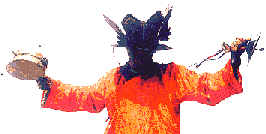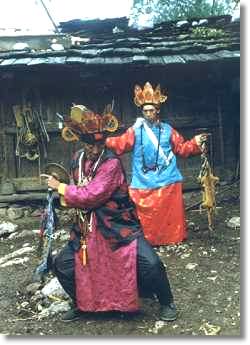Dongba Culture
Introduction to the ancient Dongba culture Long ago in the mists of antiquity, a large and powerful tribe of nomadic yak herders roamed the grasslands of northern China. Conflicts within the tribe, and the never-ending search for new grazing lands, impelled a branch of this tribe to set off on a lengthy migration south. Legend has it that the Naxi people's shamanistic Dongba religion first appeared during the course of their great southern migration, gradually maturing after they settled in their new home. This industrious people made paper from the bark of mountain shrubs, pens from bamboo, and ink from soot, and created a unique pictographic script based on the many forms of Nature.
Dongba shamanism is the religion of the entire Naxi nationality. With origins in ancient Naxi magic, the Dongba religion is based on worship of a pantheon of deities and the animistic belief that all living beings have a spirit. It contains strong elements of Tibet's pre-Buddhist Bon religion, Buddhism, and Daoism, and expresses a deep understanding of life and the world through respect for Nature and worship of ancestors. The shamans of the Dongba religion are referred to as Dongbas, a word which means "Wise One" or "Master." The Dongba shamans are deeply attuned to Heaven and Earth, fortune and misfortune. They can invoke the deities and appease demons, pray for luck, and avert evil. The position is hereditary, passed from generation to generation within a family, with the shamans preserving and disseminating the ancient Dongba culture of the Naxi people. Naxi Dongba culture has been of great interest to international academic circles since the 19th century, with the first ethnological studies undertaken in 1885. International scholars believe that research into Dongba culture can shed light on many mysteries on human cultural development. Seen from this perspective, Dongba culture is not only the treasure of China's Naxi people, but part of the cultural heritage of all humanity. The line of succession of Dongba shamans is currently facing a crisis. Out of the total Naxi population of 280,000, there are fewer than twenty living full Dongba shamans, all of whom are extremely aged. It is likely that within the first decade of the new millennium, these elders will all have passed on. If this imminent break in the transmission of the ancient Dongba tradition cannot be prevented, this living culture will soon become no more than a memory. Preserving Dongba culture has become the urgent responsibility of all the peoples of the world.
|
Copyright © - Zhang Xu (Tayou Lamu)
 print this page
print this page 

